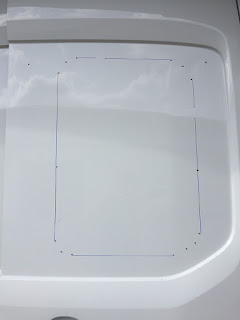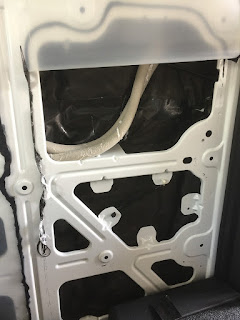Ford T350 Stealth Van Conversion
This is a blog to follow the conversion of a T350 Cargo van to a camper
Monday, March 20, 2017
Thursday, March 16, 2017
Window Installaion
We wanted to add two rear windows and two side windows. One behind the drivers seat and one in the sliding glass door behind the passenger seat.
First - it was very hard to find the part numbers. I finally used Safelite to order the windows from and do the installation. The only issue (issues abound) was that they do not cut the holes. So I had to do that. Not particularly hard but NOT for the faint of heart.
Best tool to use is a Bosch jig saw with very fine (30-35 point teeth I think) saw blade. I tried a sawzall but it is to inaccurate. My advice is to make a pattern and lay it out on the outside using pilot holes lined up by drilling from the inside.
Use tape to protect the finish and make sure you spray silicone on the bottom of the jig saw.
Have at least 3 spare saw blades. Never extract the blade unless it is fully stoppped. Use a sharpie. Measure three times - cut once. Make sure you can see what you are doing. Use safety glasses, ear protection and a dust mask.
Rear windows are different sizes and you use the outside of the raised area. Drill pilot holes and then lay it all out on the outside.
Cut slowly and use a small ladder.
Once done use a file to smooth rough edges and then prime the raw metal.
Safelite had some cool black primer. It dried fast.
We then installed the trim lock edge material to give a finished look. The interior hook was on the inside so the outside was smooth and flat.
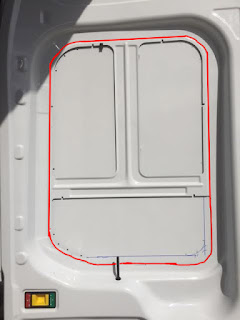 |
| Left Window - do not cut off the lock pull |
 |
| Right Window |
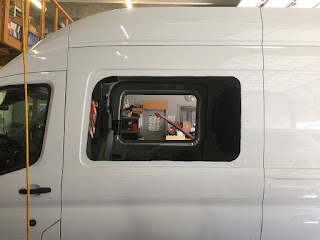 |
| Completed cut on drivers side |
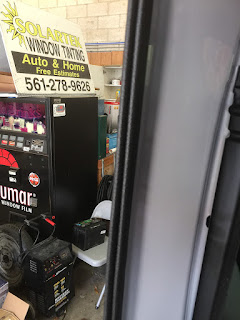 |
| The back windows needed only a single Trim Lock. The sides needed two. One for each sharp metal edge. |
 |
| One window in - three more to go. |
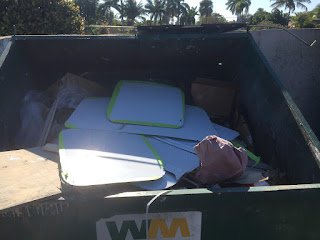 |
| The excess metal tossed away - careful - very sharp |
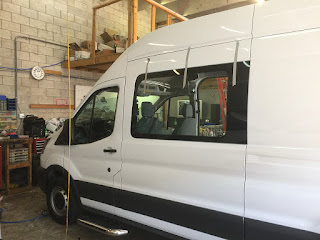 |
| Drivers side glass installed |
Roof Top Vent
Some say that installing the roof top vent is almost harder than insulation. They may be right.
I did the install by using these instructions which I have edited for clarity
Tips for the Roof Vent Adapter:
We recommend Window-weld adhesive which you can get at Napa.
>> Some use 3M 4200 as well. I think any quality caulk would work well.
Locate and cut the 14 x 14 hole. This is generally between the two frames that are in fact 14" apart. You can use the adapter as a guide to mark the hole. Stay clear of roof supports, obviously.
Make a tape line 1/4" beyond the adapter perimeter.
De-gloss the area with a Scotch- brite pad. No need to scuff. Just dull the paint.
Clean with isopropyl alcohol and let dry thoroughly. Blow dryer if it's wet and/or cold out.
Apply three (generous) 1/8" beads of the Window-weld on the face of the adapter. Then press the adapter down onto the roof until the adhesive oozes out the sides. (I was not generous enough on my application. It's not necessary to clamp. If you do, use a lot of lightly set clamps and spread out the clamp force over the whole surface area. (I used12 lightweight spring clamps.)
Using the adhesive that oozes out, make a fillet around the adapter with a double gloved finger. (Just in case one breaks).
Pull the tape within 15 minutes. Cure is fast on outside. Let cure overnight and then proceed with the fan install.
(I changed these steps to drill before the butyl tape. )
First Buy REALLY GOOD HIGH QUALITY BITS
Drill two 9/64" pilot holes through the adapter but stop before you cut into the roof.
Then use the 3/32" drill bit to make holes that go all the way through the roof and any frames below.
Now use two screws on the sides (1 1/4") to secure the flange and drill the rest of the holes.
Again use the 9/64" to make pilot holes and then 3/32" to drill through the metal.
Then use the 9/64" bit from below to open up the 3/32" holes where they penetrate the roof ribs. STOP before you drill through the actual roof. A stop bit, if you can find one, will work.
and into the van roof. Only where you are into a roof support beam should you drill a clearance hole in the beam. You only want the screw to engage the adapter and outer skin. The screw attaches to the metal roof only and that hole has to be 3/32"
You will need longer screws, I used 1 1/4" screws for the sides that are parallel to the sides of the van. The 1" screws (provided with the Maxx Air 7000 fan) were fine for the front and back of the flange.
I used the recommended butyl tape for the fan install. I covered the fan flange with 1 1/8" wide tape. Placed the flange onto the adapter and pressed down.
Then tighten the screws very lightly against the fan flange. Some butyl will ooze out which you can trim off.
After all screws are in coat the fan flange adapter and onto the roof about 1/2" with brush on bed-liner or Flexseal from the TV guy works well. Some sealants will melt the fan plastic so you might try it on a portion of the interior bezel first. You'll cut a lot of that piece off. Good idea to check the integrity and reapply the sealant every so often.
Dicor self leveling sealant also works but looks a little messy.
 |
| Roof van flange installed on the Impact 3D Shim. I used 3/32" to pre-drill the roof for the #10 screws I used 9/64" drill bit to clearance drill the Transit Roof machined shim from Impact 3D |
 |
| Roof fan installed |
Floor Insuation and reworking
The floor had factory vinyl on it and so we decided to redo that area.
 |
| Original vinyl floor before I pulled it up and before the panels were removed from the walls. |
 |
| Tearing the vinyl off of the fock. This material could hold water and so we removed it. |
 |
| Installing the 1/2 foam where the flock used to be. This was a tedious job |
 |
| 4" inspection port cut into the left side of the van - this will be for the electric shore power |
Insulating the van with Thinsulite
The insulation we chose was provided by Hein at Impact 3D
This product was really a joy to work with. We ordered 70 feet x 5 feet wide. The width is standard.
We are not done yet but expect to have some left over.
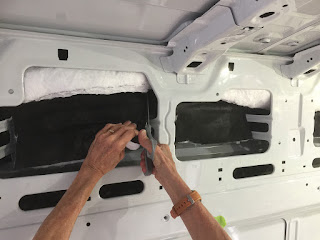 |
| Installation of the insulation - rolled it up and then cut around the ribs |
 |
| Installation by pulling the insulation through the smaller ribs |
 |
| Example of cutting the insulation around the ribs |
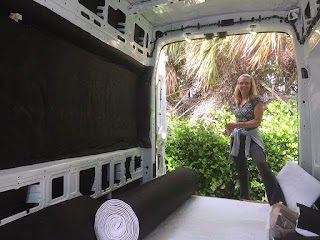 |
| Insulation was easy to work with. Here the right side was already insulated |



